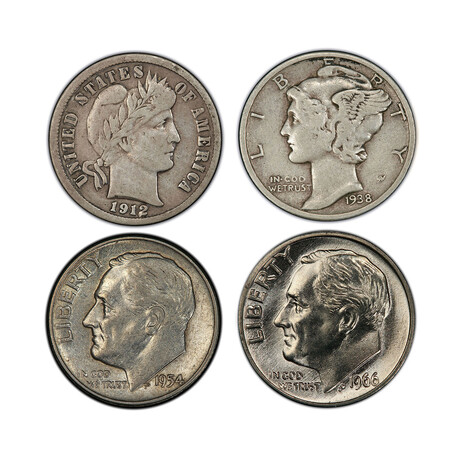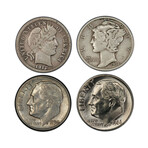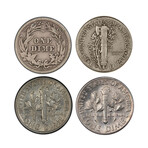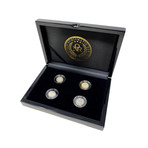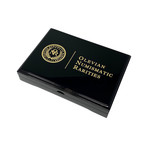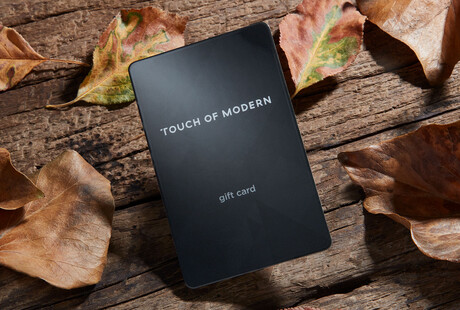Olevian Numismatic Rarities
20th Century U.S. Dime Collection // Relics of a Bygone Era Series // Wood Presentation Box
Product Description
This 4-coin set features one of every major type and composition of U.S. 10-cent piece issued during the 20th century. Each set includes a Barber dime (1892-1916), Mercury dime (1916-1945), and two Roosevelt dimes, including one struck in the original silver alloy (1946-1964) and one in the contemporary copper-nickel alloy (1965-present). Each coin is housed in an airtight capsule. The set is presented in a luxurious, plush-lined wood box with embossed metallic gold lettering, piano-black finish, and certificate of authenticity. The coins are unconditionally guaranteed to be genuine, dated between 1900 and 1999, and will match the quality of the ones shown.
By 1891, the public had grown weary of the Seated Liberty coinage that had clinked in their pockets for over 50 years. Consequently, U.S. Mint director Leech instructed Chief Engraver Charles E. Barber to prepare designs for the coins that now bear his name. The result was a new dime, quarter, and half dollar rendered in a distinctly neoclassical Roman design that drew influence from contemporary French coinage circulating in Europe. The Barber obverse features Liberty, facing right, wearing an olive branch crown termed a pileus, as well as a headband inscribed with LIBERTY. The Barber dime reverse design shows a wreath encircling the denomination, like that of the Seated Liberty dime, but different from the Barber quarter and half dollar. Barber coins were produced from 1892 through the middle of the first World War in 1916, except for the half dollar, which ended one year earlier.
Properly known as the “Winged Liberty” dime in the Mint’s official description, this popular coin features a stunning example of a youthful Lady Liberty on the obverse wearing a winged Phrygian cap to symbolize freedom of thought. However, this was publicly confused almost immediately after its release in October of 1916 with a likeness of the Roman God Mercury, and thus this coin’s enduring colloquial name was born. The reverse features the fasces carried by Roman magisterial lictors and symbolizes power and justice, as well as strength in numbers, and is accompanied by an olive branch of peace. The Mercury dime spanned an era that witnessed two World Wars, the Roaring Twenties, the Great Depression, and the entirety of Prohibition. It continues to be one of the most beloved coins in American history, more than 70 years after its last mintage in 1947.
Franklin Delano Roosevelt served as the 32nd president of the United States from 1933 until 1945 and was the only president elected to 4 terms. A central figure in world events during the first half of the 20th century, Roosevelt died in office on April 12th, 1945. As the country mourned its fallen leader, the American public was eager to memorialize Roosevelt in some significant way. Within the Treasury Department, plans were quickly laid for the introduction of a new coin to honor Roosevelt. Since the late president had been afflicted with polio, the dime was chosen to bear his portrait—a testament to the “March of Dimes” fundraising campaign to end Polio that began during Roosevelt’s first term. Straying from a 40-year tradition of enlisting outside artists, U.S. Mint Chief Engraver John R. Sinnock was appointed to design the new coin. The model ultimately chosen for production featured a large left-facing portrait of Roosevelt on the obverse, while the reverse featured an upright torch to symbolize freedom, flanked by branches of olive and oak, representing peace and victory. Notably, the small initials “JS” of the designer also appeared below Roosevelt’s portrait, which resulted in unexpected controversy shortly after the coin was released in 1946. With America newly concerned by the post-war threat of the Soviet Union, a rumor quickly spread that the initials JS were those of Soviet leader Joseph Stalin. As ludicrous as this may seem now, the U.S. Mint was forced to issue a statement identifying John Sinnock as the coin’s designer and dispelling any claims of a communist connection. The Roosevelt dime continued to be struck in silver every year, until rising bullion prices necessitated a compositional change to copper-nickel clad in 1965. Today, the Roosevelt dime enjoys widespread circulation and continues essentially unchanged in design since its introduction over 70 years ago.
Product Details
- Measurements
8"L x 6"W x 2"H
- OriginUnited States
Coin 1:
— Type: Barber Dime (1892-1916)
— Designer: Charles E. Barber
— Weight: 2.5 grams
— Diameter: 17.9 mm
— Composition: 0.900 silver, 0.100 copper
— Net silver weight: 0.07234 oz pure silver
— Obverse Design: Liberty, facing right, with pileus and headband
— Obverse Inscription: UNITED STATES OF AMERICA / LIBERTY / DATE
— Reverse Design: Wreath of corn, wheat, maple, and oak
— Reverse Inscription: ONE DIME
Coin 2:
— Type: Mercury Dime (1916-1947)
— Designer: Adolph A. Weinman
— Weight: 2.50 grams
— Diameter: 17.9 mm
— Composition: 0.900 silver, 0.100 copper
— Net silver weight: 0.07234 oz pure silver
— Obverse Design: Liberty with winged cap
— Obverse Inscription: LIBERTY / IN GOD WE TRUST / DATE
— Reverse Design: Fasces with axe / Olive branch
— Reverse Inscription: UNITED STATES OF AMERICA / E PLURIBUS UNUM / ONE DIME
Coin 3:
— Type: Roosevelt Dime (1946-Present)
— Variety: Silver (1946-1964)
— Designer: John R. Sinnock
— Weight: 2.50 grams
— Diameter: 17.9 mm
— Composition: 0.900 silver, 0.100 copper
— Net silver weight: 0.07234 oz pure silver
— Obverse Design: Franklin Roosevelt, facing left
— Obverse Inscription: LIBERTY / IN GOD WE TRUST / DATE
— Reverse Design: Torch flanked by olive and oak branches
Coin 4:
— Type: Roosevelt Dime (1946-Present)
— Variety: Copper-Nickel (1965-Present)
— Designer: John R. Sinnock
— Weight: 2.27 grams
— Diameter: 17.9 mm
— Composition: 75% copper, 25% nickel over a pure copper center
— Obverse Design: Franklin Roosevelt, facing left
— Obverse Inscription: LIBERTY / IN GOD WE TRUST / DATE
— Reverse Design: Torch flanked by olive and oak branches
— Reverse Inscription: UNITE STATES OF AMERICA / E PLURIBUS UNUM / ONE DIME
Please Note: The item(s) you receive will match the quality of the one shown, but may vary slightly due to the nature of original historical artifacts.
Shipping Information
-
Shipping AvailabilityCanada, United States
-
Shipping PolicyStandard Ground Shipping
-
Ship In3-4 weeks ⓘ
-
Return PolicyFinal sale, not eligible for return or cancellation
